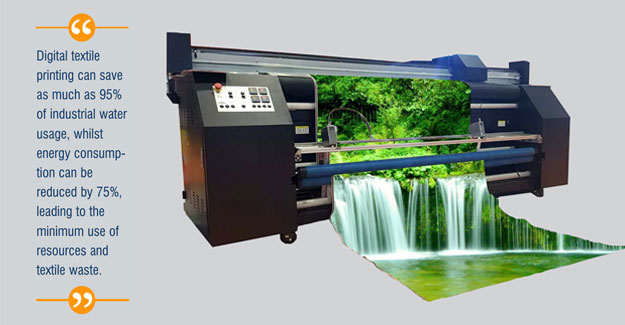
Digital Textile Printing Scores Solid Sustainability Points
Digital textile printing, widely seen as the future of industrial textile printing, is estimated to account for around six percent of the world's printed fabric by volume. The share is expected to increase exponentially over the next few years, as the industry is realising the quality, cost, environmental benefits of digital textile printing.
The EFI-Bolt Industrial Single Pass digital textile printing machine recently hit the 50 million printed metres milestone, and signposts the future of industrial textile production using digital equipment.
Digital textile printing is comparatively waterless
 According to Ellen Macarthur Foundation, over 20% of industrial water pollution globally is attributable to the dyeing and treatment of textiles. And here, digital textile printing comes to the rescue. When measured against analogue textile screen printing, digital textile printing systems are comparatively waterless.
Simplifying the production process to remove the unnecessary use of water is paramount. Pigment inks therefore offer an efficient solution when combined with digital technologies. Single step production goes further in removing the need for pre-coating and post-finishing of fabrics. Kornit Digital offers a one-step process in their machine the Kornit Presto, which coats the fabric using inkjet technology in-line, as ink is applied to the surface of the fabric (wet on wet) and then dries it in one pass - saving water and energy. High quality printing is achieved using the Fujifilm - Dimatix Starfire printhead and generates millimetric accuracy of print mark with no waste.
Digital textile printing can save as much as 95% of industrial water usage, whilst energy consumption can be reduced by 75%, leading to the minimum use of resources and textile waste.
The digital print process is made to be sustainable
In the digital printhead, there are much smaller physical forces to overcome as the ink is applied. The Piezo-electric print head generates an ink droplet after an electric charge actuates a vibration plate inside the printhead. Each droplet consists of a precise amount of ink fired at precisely the right time according to an electronic charge relating to the detail of a design being printed. For example, an Epson Precisioncore printhead on the Epson ML8000 can deliver as little as 1.5 picolitres per droplet, exactly replicating the electronic image of the design or pattern it is printing.
The print speed of digital textile machinery has increased, driven by innovations in printhead design. The Ricoh TH5241 generates a precise 1200 dpi from 1280 nozzles, while the Kyocera KJ4 EX uses the strength and rigidity of its construction to generate fine droplets that enable high-quality printing at speed. XAAR, with its 2002 printhead delivers significantly increased printing speeds of up to 75 metres per minute at 720dpi by using the full capability of the printhead, where much higher firing frequencies of up to 36 kHz are now possible. It is in this combination of speed and precision that the economies of water and energy are generated.
As a result, the average volume of water consumption in digital textile printing at 5-9 cc per metre, contrasts with the large amount of liquid volume of 50-60 cc per metre consumed in rotary or flat screen printing. Apart from the difference between the actual physicality of the rotary screen printer compared to a digital textile printer, the amount of water to be dried in digital textile printing is so much lower, with the result that a dry fabric can be achieved with a fraction of the energy used in traditional screen printing.
(Fespa)
According to Ellen Macarthur Foundation, over 20% of industrial water pollution globally is attributable to the dyeing and treatment of textiles. And here, digital textile printing comes to the rescue. When measured against analogue textile screen printing, digital textile printing systems are comparatively waterless.
Simplifying the production process to remove the unnecessary use of water is paramount. Pigment inks therefore offer an efficient solution when combined with digital technologies. Single step production goes further in removing the need for pre-coating and post-finishing of fabrics. Kornit Digital offers a one-step process in their machine the Kornit Presto, which coats the fabric using inkjet technology in-line, as ink is applied to the surface of the fabric (wet on wet) and then dries it in one pass - saving water and energy. High quality printing is achieved using the Fujifilm - Dimatix Starfire printhead and generates millimetric accuracy of print mark with no waste.
Digital textile printing can save as much as 95% of industrial water usage, whilst energy consumption can be reduced by 75%, leading to the minimum use of resources and textile waste.
The digital print process is made to be sustainable
In the digital printhead, there are much smaller physical forces to overcome as the ink is applied. The Piezo-electric print head generates an ink droplet after an electric charge actuates a vibration plate inside the printhead. Each droplet consists of a precise amount of ink fired at precisely the right time according to an electronic charge relating to the detail of a design being printed. For example, an Epson Precisioncore printhead on the Epson ML8000 can deliver as little as 1.5 picolitres per droplet, exactly replicating the electronic image of the design or pattern it is printing.
The print speed of digital textile machinery has increased, driven by innovations in printhead design. The Ricoh TH5241 generates a precise 1200 dpi from 1280 nozzles, while the Kyocera KJ4 EX uses the strength and rigidity of its construction to generate fine droplets that enable high-quality printing at speed. XAAR, with its 2002 printhead delivers significantly increased printing speeds of up to 75 metres per minute at 720dpi by using the full capability of the printhead, where much higher firing frequencies of up to 36 kHz are now possible. It is in this combination of speed and precision that the economies of water and energy are generated.
As a result, the average volume of water consumption in digital textile printing at 5-9 cc per metre, contrasts with the large amount of liquid volume of 50-60 cc per metre consumed in rotary or flat screen printing. Apart from the difference between the actual physicality of the rotary screen printer compared to a digital textile printer, the amount of water to be dried in digital textile printing is so much lower, with the result that a dry fabric can be achieved with a fraction of the energy used in traditional screen printing.
(Fespa)

Textile Excellence
If you wish to Subscribe to Textile Excellence Print Edition, kindly fill in the below form and we shall get back to you with details.








